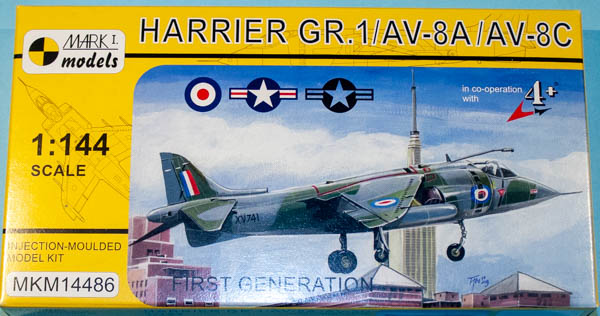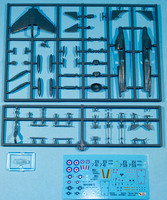
Mark I 1/144 Hawker Siddeley Gr.1 Harrier
By Matt Bittner
Introduction
According to Wikipedia:
The Hawker Siddeley Harrier is the first of the Harrier Jump Jet series of aircraft. It was developed in the 1960s as the first operational close-support and reconnaissance fighter aircraft with vertical/short takeoff and landing (V/STOL) capabilities and the only truly successful V/STOL design of the many that arose in that era. The Harrier was developed directly from the Hawker Siddeley Kestrel prototype aircraft, following the cancellation of a more advanced supersonic aircraft, the Hawker Siddeley P.1154. The British Royal Air Force (RAF) ordered the Harrier GR.1 and GR.3 variants in the late 1960s. It was exported to the United States as the AV-8A, for use by the US Marine Corps (USMC), in the 1970s.
This is the first injected kit of the early-series Harrier in 1/144. It's definitely a nice addition to the scale.
The Kit
The Mark I 1/144 Hawker Siddeley Gr.1 Harrier consists of 58 pieces of gray (some not used with this release), injected plastic and one clear injected one-piece canopy. Decals are for four Harriers:
- Hawker Siddeley Gr.1 Harrier, XV741, Aeroplane and Armament Experimental Establishemt (A&AEE), MoD/RADF, Boscombe Down Air Base, Wiltshirte, U.K., flown by Flt. Lt. T. Lecky-Thomposn during the Daily Mail Transatlantic Air Race, May 1969
- Hawker Siddeley Gr.1 Harrier, XV759, No.233 OCU (Operational Conversion Unit), RAF, Wittering Air Base, Cambridgeshire, U.K., 1971
- AV-8A Harrier (Hawker Siddeley Harrier Mk.50), BuNo 158707/WH12, White 12/Black WH, VMA-542 (Marine Attack Squadron 542_ 'Tigers', US Marine Corps, MCAS Cherry Point, North Carolina (detachment MCAS Yuma, Arizona), U.S.A., 1974
- AC-8C Harrier (Hawker Siddeley Harrier Mk.50), BuNo 15937/KD14, White 14/KD, VMAT-203 (Marine Atatck Training Squadron 203) 'Hawks', US Marine Corps, MACS Cherry Point, North Carolina, U.S.A., mid-19802
All but the AV-8C are finished in Dark Green and Dark Sea Gray upper, with Light Aircraft Gray on the undersides, while the AV-8C has Dark Green and Gunship Gray upper sufaces with Light Gull Gray on the undersides. The decals appear to be in register and are nicely printed.

|
Of course construction starts with the cockpit, and once it's all painted and assembled can be glued into one fuselage half. Glue in the engine fan - again, after painting - and then assemble the fuselage halves. Also added at this point are the intakes.
Now you add the single-piece wing and if building the first aircraft mentioned above, you'll also need to perform some surgery to add different wing tips. Once the wing is added - or even before - the instructions have you add the side-exhausts (but the instructions only show them in one position - no idea if they can be posed in a different way), the tail pieces, the nose cone, the refueling probe (if being used), the canopy, the nose pitot and an antenna on top of the fuselage. Those last two items are best left off until after painting and applying the decals.
The final instruction step has you add everything to the underside, most pieces best left off until after painting and decaling, although there are a few items you'll want to add prior to painting. Study the instructions carefully.
Conclusion
Once the Mark I 1/144 Hawker Siddeley Gr.1 Harrier is assembled and painted, you'll have an excelllent rendtion of the early Harrier sitting on your shelf. Pick up the separate Detailing and Weapon Set and you'll have more stores to add to your model, along with replacement intakes (with cooling doors down) and a better looking ejection seat.
While I would like to thank Kits-Shop for the review kit, unfortunately they went out of business.
